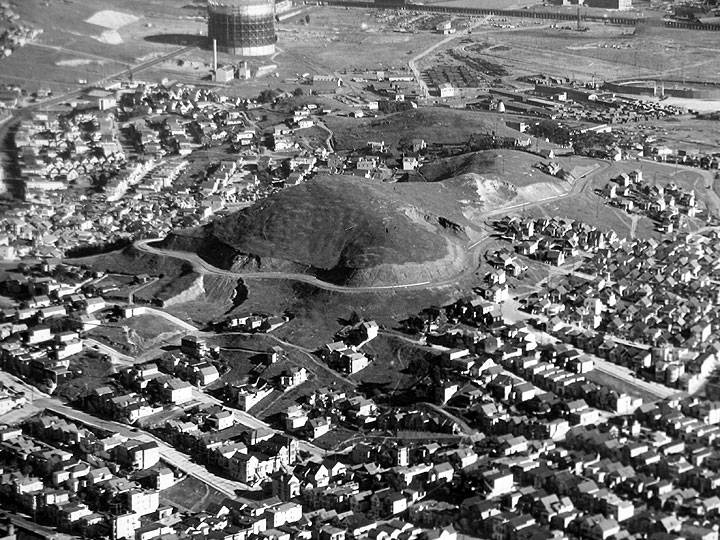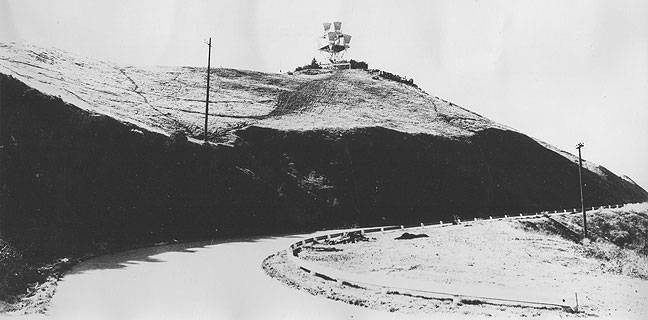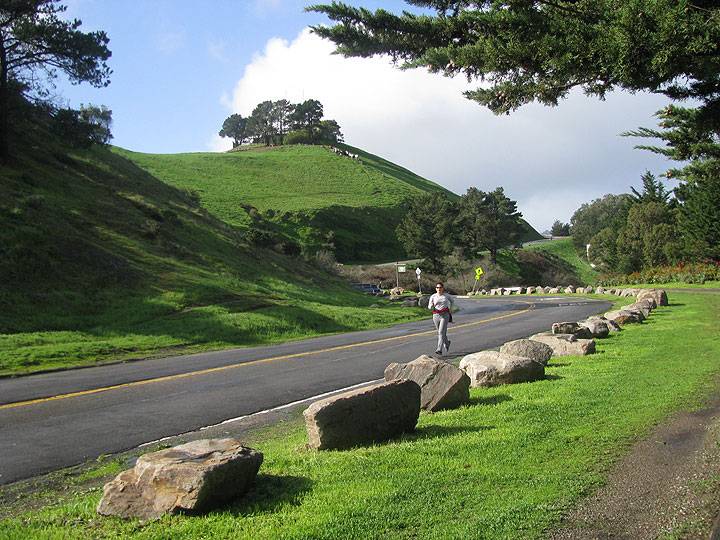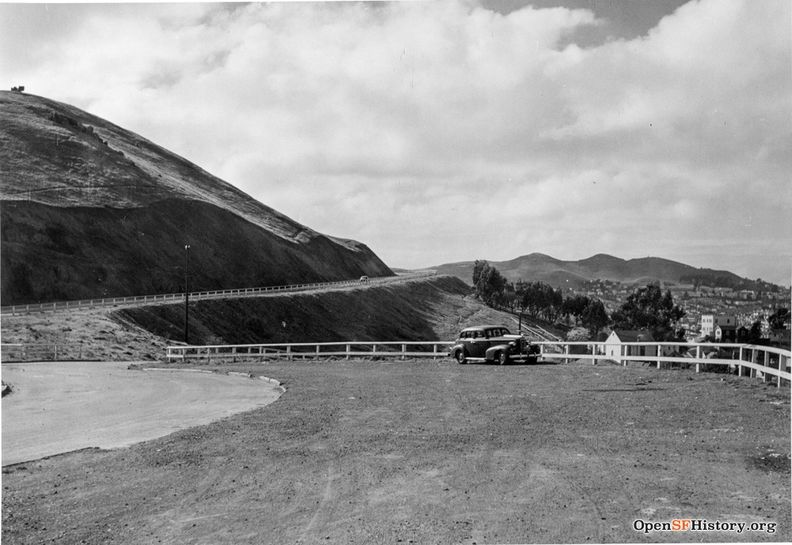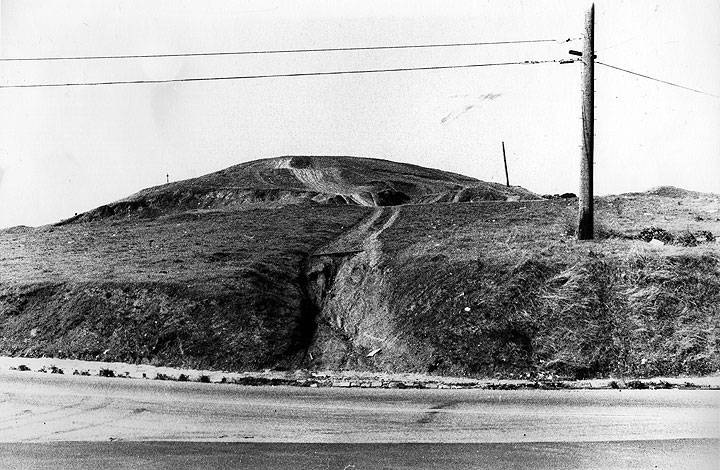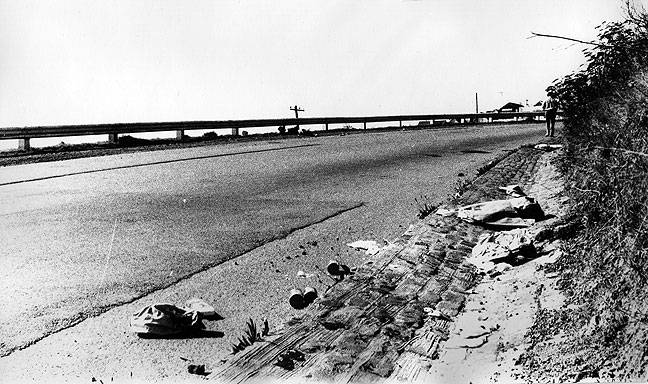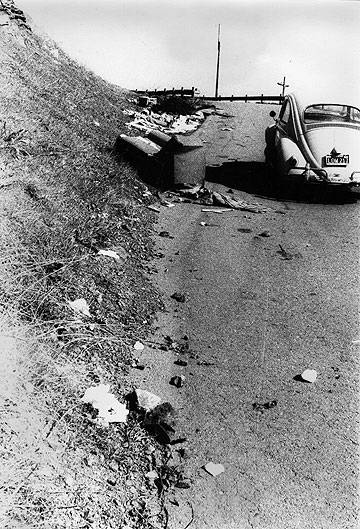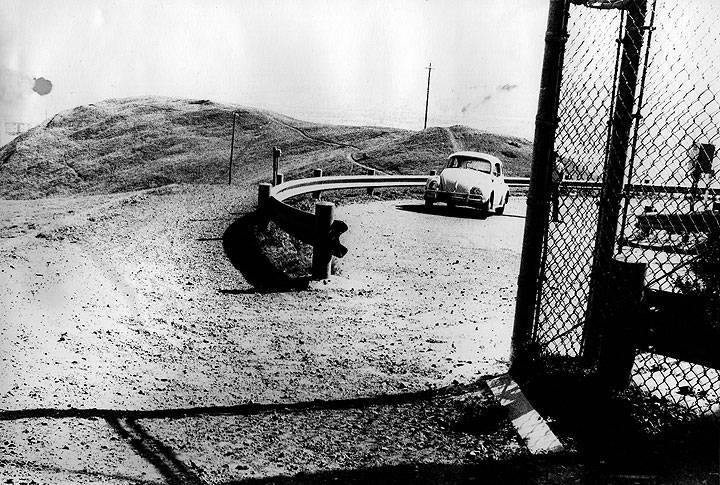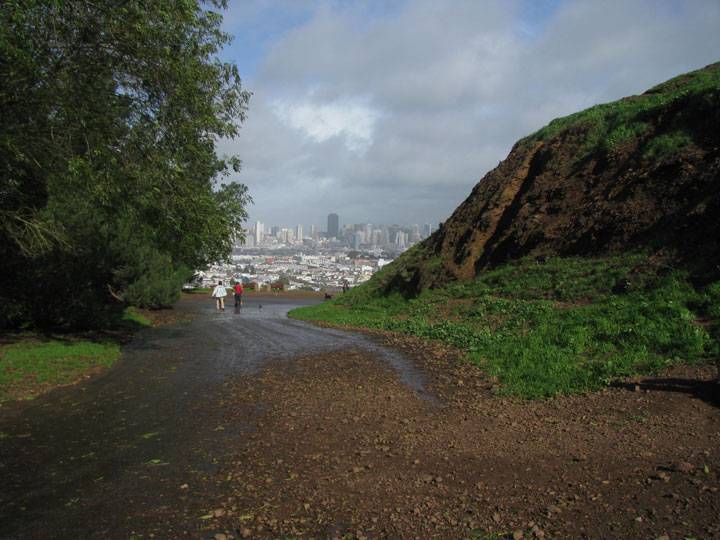Bernal Heights Boulevard: Difference between revisions
mNo edit summary |
(added photo) |
||
| Line 31: | Line 31: | ||
''Photo: Chris Carlsson'' | ''Photo: Chris Carlsson'' | ||
[[Image:Bernal Heights Blvd circa 1940 wnp27.0513.jpg|792px]] | |||
'''Bernal Heights Boulevard, c. 1940.''' | |||
''Photo: OpenSFHistory.org wnp27.0513'' | |||
Vehicle access to the boulevard was obtained at Folsom Street, Bradford and Esmeralda avenues, and Anderson and Ellsworth streets, just as they are now. Of course, you might count the ungraded western extension of Mayflower Street on the west side of Carver, but that can be a harrowing ride for a low-slung car. | Vehicle access to the boulevard was obtained at Folsom Street, Bradford and Esmeralda avenues, and Anderson and Ellsworth streets, just as they are now. Of course, you might count the ungraded western extension of Mayflower Street on the west side of Carver, but that can be a harrowing ride for a low-slung car. | ||
Revision as of 23:04, 12 January 2020
Historical Essay
by Jerry Schimmel
In the mid-1920s Bernal Heights had no boulevard circling it. On the hillside are the letters spelling out "MAXWELL," an ad for an auto company at the time. The Islais Creek wetlands and Hunters Point are at the top of the photo.
Photo: San Francisco History Center, SF Public Library
By the mid-1930s, the ring road was built around the hill. This photo was probably taken sometime between 1938 and 1947. At top, left of center, is a large PG&E gas storage tank, and just below it a small building with a large chimney, which was the failed trash incinerator.
Photo: San Francisco Planning Commission
In 1966, the boulevard was an irregular circle open to vehicle traffic all the way around the hill, a view-studded ride to nowhere torn out of pastoral slopes in 1935, a make-work WPA project supervised by the famous engineer, O'Shaughnessy.
When we arrived there were no park gates at Folsom or Moultrie streets, nor any park. The white steel guardrail snaked along next to the boulevard, preventing hot rodders and distracted drivers from plunging over the edge into someone's downslope backyard. The verge between the rail and boulevard was an unpaved dirt shoulder separated from blacktop by rotting 2x6 planks stuck in the ground, edge down.
Bernal Heights from North side, near intersection of Bernal Heights Boulevard and Folsom Street, showing motorcycle tracks and scars, 1972.
Photo: Jerry Schimmel
Further east of Folsom, but otherwise the same view as above, this one during the wet winter of 2010.
Photo: Chris Carlsson
Bernal Heights Boulevard, c. 1940.
Photo: OpenSFHistory.org wnp27.0513
Vehicle access to the boulevard was obtained at Folsom Street, Bradford and Esmeralda avenues, and Anderson and Ellsworth streets, just as they are now. Of course, you might count the ungraded western extension of Mayflower Street on the west side of Carver, but that can be a harrowing ride for a low-slung car.
Bernal Heights from East end, showing bike trails and bike entrance at intersection of Carver Street and Bernal Heights Boulevard, 1972.
Photo: Jerry Schimmel
Two sections of the hilltop, one at the west end and a smaller one across from Rosenkranz Street, were, as the story goes, quarried as early as the late 1940s and later used to provide fill for the 101 freeway and Candlestick Park. The enormous scars are plainly visible now, and no doubt always will be. That was the value of Bernal Hill to San Francisco in the mid-20th century.
Whole or partial foundations for two houses still exist above the boulevard where Prentiss Street would intersect had it been paved, isolated from the rest of the neighborhood by the roadway construction. According to directories, the street numbers were 26 and 39, and the buildings were in use as late as 1963. Number 26, the last to be occupied, was set ablaze for Fire Department training in 1964 or '65. Charles Parker was the final tenant, though I doubt if he was a musician.
A crumbling dirt road to the former homesites is traceable starting at the east quarry, looping above and around the excavation, and ending across from the Prentiss footpath, soon to be a city stepwalk. The handsome stone wall below the foundations was installed to keep the original structures from falling into the boulevard. It has proved equally handy as a graffiti canvas.
Bernal Heights showing south side showing garbage dumped along Bernal Heights Boulevard near Banks Street, 1972.
Photo: Jerry Schimmel
As we came to realize, our semirural tranquility would come at a price. The hill was actually a large open wasteland under nominal purview of the Department of Public Works, known by most as DPW. The west and east quarries were in regular use as auxiliary dumps by citizens too cheap, poor, or lazy to pay for hauling or couldn't manage the drive to Beatty Avenue. Neighborhood residents were among the offenders, if not the worst. I remember Gloria Jiunti at 44 Mullen Avenue once sounding off about a load of worn car parts: "Aw, take it up on the hill and dump it!" And her attitude was not uncommon.
Like the quarries, the roadside verge was and still is an easy place to leave anything from a stained, lumpy mattress to the aromatic leftovers of Saturday night's blowout. Some dumpers put their trash behind the guardrail (and still do) in a guilty effort to hide it, making it that much harder to retrieve.
In 1966, street sweepers made regular trips to keep the boulevard clear, but in order to get a really big mess hauled away from the quarries, several residents simultaneously had to put the screws on DPW's Army Street office. I remember phoning them only to be asked, "Haven't you called before?" My name apparently got on a watch list of purported serial illegal dumpers, the logic being if you called a lot you must be one of them. These days illegal dumping has ballooned into a citywide problem, and DPW had to develop a special phone number and pickup unit. I should call and see if my name is still on that list.
Bernal Heights: Showing garbage dumped along Moultrie Street above Bernal Heights Boulevard, 1972.
Photo by Jerry Schimmel
On the positive side one can sometimes find useful objects in the debris, like lumber, the occasional chair or dresser in repairable condition, and car parts. Few of the latter have been of value except as scrap. Even so, it's still fun to poke through a day's leavings and find something of value. A nice solid white bookcase stands in my basement, good as new, the result of one afternoon's gleaning.
The AT&T microwave transmission tower at the top of the hill was constructed in 1962 and surrounded by a minimal chain-link fence. There was no boulevard-level gate to its roadway, but the road surface was blacktopped as it is now. Greta Van Praag (74 Prospect Avenue) was instrumental in getting the pine trees planted, a partly successful attempt to soften the techno-silhouette of the tower. Some residents wish the tower would go away, but most have acquiesced to its presence. A very small minority considers it to be Bernal Heights' version of the Eiffel Tower, a landmark of sorts. The comparison is a stretch.
Top of Moultrie Street at Telephone Company installation, showing a major biker entrance (between chain link fence and guard rail), 1972.
Photo by Jerry Schimmel
In the late '60s, a trek around the boulevard or along the saddle of the hilltop could leave a lone hiker with the impression of a barren, even abandoned landscape. There were few trees then, most noticeably the giant blue gums on the north side above Shotwell and Stoneman streets and some evergreens at the Esmeralda steps. It was hard to keep from looking over your shoulder especially if you were on foot unaccompanied.
Not many walked alone on the boulevard in daytime, and no one did at night unless it was unavoidable. Those who did were invariably men. I doubt if women considered going there unescorted, at least I don't remember many, not like there are now. I recall seeing cars lazily cruising the circle at odd times as though they had nothing better to do, their drivers eerily peering from side to side, often slowing down to look closely at a pedestrian. I always wondered what they were up to or expecting to see.
During late evenings and the wee hours, the boulevard converted into a crude unsupervised lovers' lane and party locale. It could get noisy, especially if you lived between Ellsworth and Andover streets where homes belly up to the road. Bottles, cans, and used condoms lined the pavement each morning, and still do, testifying to the night's fun, often cluttering the parking lane for weeks until the city's behemoth street sweepers came along. In spite of the natural beauty of the hill and surrounding slopes, the area was an unimproved, unsupervised urban open space that could be a magnet for the unpleasant.
On the other hand, daytime views from the roadside were as inspiring as they are now, and a climb to the tower would invariably reward hikers with a new adventure on every uphill trek. When kite fliers gathered en masse at the top on a breezy day, the positive energy could be exhilarating.
One time I thumbed through a city directory from the 1890s and happened on an entry listing a tiny saloon high up at 7 Prentiss Street, forty years before the boulevard was cut. In those days, few if any streets in the neighborhood were paved, and most existed as lines on paper in some city office. So up to 1935 it was possible to herd your goats from Cortland Avenue to their hillside pasture and wet your whistle while they chewed the weeds. The bar must have been in the basement of one of the long-gone structures. (In 1900 there were 3,000 liquor licenses for a city of 300,000 men, women, and children.)
And, of course, there's the story of a phony gold strike on the hill at the same time. Or maybe it was 1876. But that will be a long-term research project for someone. You can't find it on the Internet, no matter what they tell you.
Jerry Schimmel was a professional social worker who moved to Bernal Heights in 1965, living first on Winfield Street and settling finally at the top of Prentiss Street. He was the director of the small community center at Precita and Alabama streets for four years from 1967 to 1971, and then remained active in neighborhood politics through the 1980s from whence he is now more or less retired. He has lived on Prentiss Street since December 1966. This article originally appeared on the Bernal History Project website here.
Bernal Heights Boulevard, January 2010, just after heavy winter storm.
Photo: Chris Carlsson


